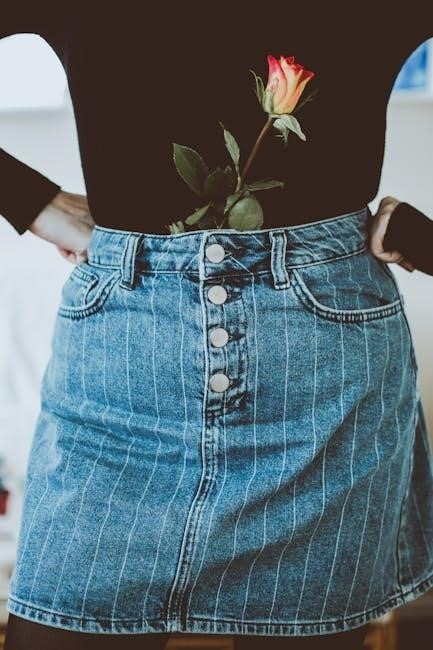Discover the world of free PDF skirt patterns, perfect for sewists of all skill levels. Explore various styles, from bias-cut to tiered designs, with tutorials and guides included.
Types of Skirts
Explore the diverse range of skirt patterns, from bias-cut and tiered to A-line, pencil, maxi, and pleated designs, each offering unique styles and sewing experiences.
2.1 Bias Cut Skirts

A bias cut skirt is a stylish and elegant design created by cutting fabric on the diagonal, resulting in a fluid, form-fitting shape. This technique allows the skirt to drape beautifully, skimming the body for a flattering silhouette. Ideal for showcasing luxurious fabrics like silk or chiffon, bias cut skirts are perfect for creating a sophisticated look. They are known for their stretch and drape, making them both comfortable and visually appealing. When working with bias-cut patterns, it’s important to handle the fabric carefully to avoid stretching. This style is versatile and can be styled for both casual and formal occasions, making it a popular choice among sewists.
2.2 Tiered Skirts
A tiered skirt features multiple layers of fabric, creating a voluminous and feminine appearance. Each tier is typically narrower than the one below it, adding volume and movement. This design is perfect for achieving a flowing, romantic silhouette. Tiered skirts can be formal or casual, depending on the fabric and length. They are ideal for showcasing patterned or lightweight fabrics like chiffon or organza. When using a free PDF pattern for tiered skirts, ensure accurate layer alignment during cutting. Tiered skirts are versatile and can be styled for various occasions, making them a fun and creative sewing project. They suit different body types and offer a flattering, balanced look.
2.3 A-line Skirts
An A-line skirt is characterized by its narrow waist and wide hem, forming a “A” shape. It skims the hips and flares out gradually, creating a balanced silhouette. This style is flattering for most body types and offers ease of movement. A-line skirts are versatile, suitable for both casual and formal occasions. They can be knee-length, midi, or maxi, depending on the desired look. When sewing an A-line skirt using a free PDF pattern, choose fabrics like cotton, wool, or denim for structure. The pattern often includes a waistband and may feature darts for a tailored fit. A-line skirts are a great project for beginners, as they require minimal fitting adjustments. They can also be customized with pockets, buttons, or embroidery for a personalized touch. This classic design remains timeless and chic.
2.4 Pencil Skirts
A pencil skirt is a slim-fitting skirt that closely follows the contours of the body, typically ending just above the knee. It is characterized by a narrow, straight cut that creates a sleek, elegant appearance. Pencil skirts are often worn in professional settings and are a popular choice for a polished look. When using a free PDF pattern, opt for structured fabrics like wool, suiting, or stretch fabrics for a sharp silhouette. The pattern usually includes a zipper or slit for ease of movement. Pencil skirts can be paired with blouses or jackets for a chic ensemble. This style is ideal for those who want a sophisticated, form-fitting design that accentuates curves while maintaining a professional aesthetic. Perfect for confident, modern wardrobes.
2.5 Maxi Skirts
A maxi skirt is a floor-sweeping or midi-length skirt that offers a flowing, elegant silhouette. Perfect for both casual and formal occasions, maxi skirts are versatile and can be styled in various ways. They are ideal for creating a bohemian or sophisticated look, depending on the fabric and design. Maxi skirts often feature a natural waistline and can include details like slits or pockets. When using a free PDF pattern, choose lightweight fabrics such as chiffon, rayon, or maxi skirt-specific knits for a fluid drape. These skirts are great for all seasons and can be paired with crop tops, blazers, or even graphic tees. Their comfort and style make them a wardrobe staple for many, offering endless possibilities for personalization and creativity. A timeless choice for any fashion enthusiast.
2.6 Pleated Skirts
A pleated skirt is a stylish and versatile option that features folded sections of fabric, creating a textured, voluminous design. Pleats can be narrow or wide, depending on the desired look, and they add movement and flow to the skirt. Popular types include accordion pleats, box pleats, and knife pleats. Pleated skirts are ideal for both casual and formal wear, offering a balance between elegance and playfulness. They work well with various fabrics, such as cotton, chiffon, or silk, and can be paired with blouses, sweaters, or jackets. The pleated design flatters most body types and adds visual interest. Free PDF patterns for pleated skirts often include options for customizable pleat depths and lengths, making them a great choice for sewists of all skill levels. They are perfect for creating a standout piece in your wardrobe.
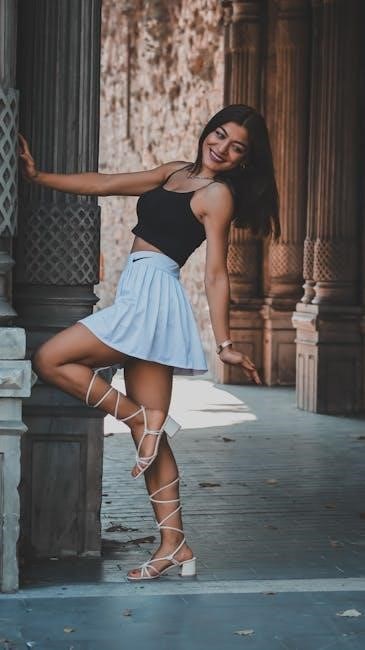
How to Use Free Skirt PDF Patterns
Using free skirt PDF patterns involves downloading, printing, and assembling the design. Ensure accurate measurements, choose suitable fabric, and follow instructions for a perfect fit and finish.
3.1 Downloading and Printing
Downloading free skirt PDF patterns is straightforward. Visit reputable websites offering free patterns, select your desired skirt style, and download the file. Ensure the pattern matches your measurements and preferred skirt length. Printing requires an A4 or letter-sized printer. Use high-quality paper for clarity. Print at 100% scale to maintain accuracy. Many patterns include a test square to verify proper scaling. Print a test page first to confirm measurements. Some patterns are split into multiple pages; ensure all are printed. After printing, carefully cut along the lines or use scissors to handle curved edges. Assembling the pattern is the next step, but focus on printing first for a smooth start.
3.2 Assembling the Pattern
Assembling a free skirt PDF pattern requires careful alignment of the printed pages. Start by laying out all pages on a large, flat surface. Use the grid or markers on each page to ensure proper alignment. Tape the pages together, matching the edges and any notches or dots provided. For accuracy, use a ruler or straightedge to guide the taping process. Some patterns may have overlapping areas or specific instructions for assembly, so follow the guide included with the download. Once assembled, the pattern will form a complete skirt shape. Double-check for any gaps or misalignments before proceeding. Proper assembly ensures the pattern fits correctly when cut and sewn.
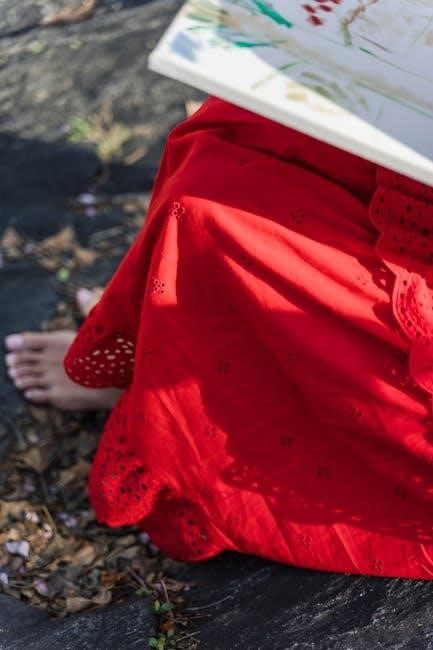
3.3 Adjusting the Pattern
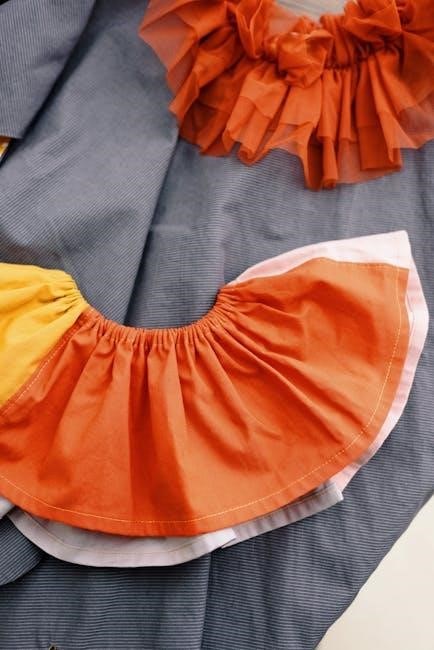
Adjusting a free skirt PDF pattern ensures a perfect fit tailored to your measurements. Begin by comparing the pattern’s sizing chart with your body measurements. Make adjustments to the waist, hips, or length as needed. For a more personalized fit, add or remove darts, adjust the waistband, or modify the skirt’s silhouette. Use a measuring tape to mark changes accurately. If altering the pattern, ensure consistency across all pieces. For major changes, consider creating a muslin prototype to test the fit before cutting your final fabric. Small tweaks can make a significant difference in comfort and appearance. Always double-check adjustments to avoid discrepancies during sewing.
3.4 Common Mistakes to Avoid
When using free skirt PDF patterns, avoid common mistakes to ensure a successful project. One of the most frequent errors is not printing the pattern at the correct scale, leading to sizing issues. Always double-check the test square provided in the pattern. Another mistake is forgetting to add seam allowances if they aren’t included. Neglecting to prewash fabric or ignoring grain lines can result in misshapen skirts. Additionally, skipping the muslin prototype step can lead to fit problems. Avoid rushing through instructions, as even small details matter. Lastly, not accounting for fabric drape or stretch can affect the final result. Careful planning and attention to detail will help you achieve a professional finish.
Fabric Requirements
Fabric requirements vary by skirt length and width. Choose fabrics suited to your pattern, ensuring enough yardage. Prewash and match fabric type to skirt style for best results.
4.1 How Much Fabric You’ll Need
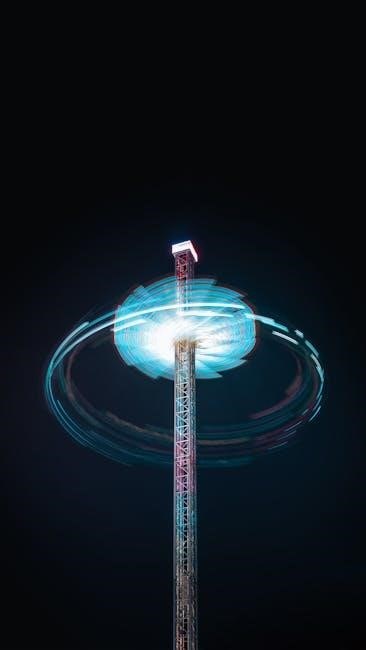
Fabric requirements vary depending on skirt length, width, and design complexity. Always check the pattern envelope or instructions for specific yardage needs. Generally, shorter skirts require 1-2 yards, while longer or flared styles need 2-3 yards. Add extra for matching patterns or adjustments. Use a fabric calculator to ensure accuracy. Prewash fabric before cutting to account for shrinkage. Measure carefully to avoid waste. If unsure, add 1/4 to 1/2 yard for mistakes or alterations. Patterns often list fabric needs based on a 45-inch width, so adjust for wider or narrower fabrics accordingly. Plan ahead to ensure sufficient material for your project.

4.2 Recommended Fabric Types
When choosing fabric for your skirt, select materials that suit the pattern and desired look. Cotton and cotton blends are ideal for casual, everyday skirts due to their durability and ease of sewing. Rayon or viscose offers a soft drape, perfect for flowy designs. Linen is great for structured, summer skirts with a natural texture. For elegance, consider chiffon or georgette, which create a lightweight, flowing effect. Satin or silk is excellent for formal skirts, providing a luxurious sheen. Denim works well for a sturdy, casual look, while corduroy adds a seasonal, textured appeal. Consider the season and your personal preference when making your choice. Always prewash fabric before sewing to ensure it doesn’t shrink after completion.
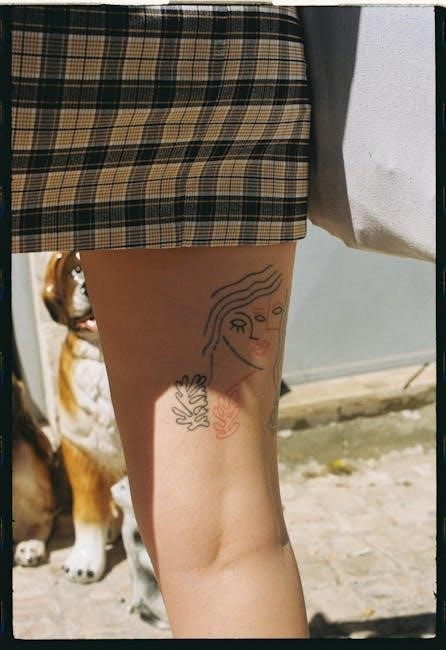
Sewing Tutorials
Sewing tutorials provide clear instructions for creating skirts, including step-by-step guides and video demonstrations to help sewists of all skill levels achieve professional results.
5.1 Step-by-Step Guides
Step-by-step guides offer detailed instructions for sewing skirts using free PDF patterns. They typically include preparation steps, cutting fabric accurately, and sewing techniques. These guides often feature diagrams and photos to clarify complex steps. Beginners benefit from tutorials on gathering, darting, and hemming. Many guides emphasize the importance of proper fabric preparation and alignment. Tips on how to handle zippers, waistbands, and linings are also common. Some guides focus on specific skirt styles, like pencil or A-line skirts, ensuring tailored advice. By following these guides, sewists can achieve professional-looking results. Practice and patience are encouraged to master each step and enjoy the sewing process.
5.2 Video Tutorials
Video tutorials provide visual guidance for sewing skirts using free PDF patterns. They often cover topics like downloading, printing, and assembling patterns. Many tutorials demonstrate fabric cutting, sewing techniques, and finishing touches. Beginners can learn how to handle zippers, waistbands, and hems through clear, step-by-step demonstrations. Some videos focus on specific styles, such as maxi or pencil skirts, offering tailored advice. Experienced sewists may find tips for customizing patterns or adding details like pockets. Platforms like YouTube and sewing blogs host numerous tutorials. These videos are ideal for visual learners, making complex steps easier to understand. They also highlight common mistakes to avoid, ensuring a polished finish. Watching tutorials can boost confidence and improve sewing skills.

Tips for Beginners
Start with simple patterns and practice on affordable fabric; Measure accurately and follow instructions closely. Use proper tools like rotary cutters and sewing machines for precise results; Take your time!
6.1 Choosing the Right Fabric
Choosing the right fabric is essential for a successful skirt project. Start by selecting fabrics suitable for beginners, such as cotton, linen, or rayon, which are breathable and easy to work with. Avoid stretchy fabrics like knits until you gain more experience. Consider the season and desired look: lightweight fabrics for summer, heavier ones for winter. Ensure the fabric has a smooth drape for a natural flow. Always pre-wash your fabric to prevent shrinkage and ensure it aligns properly with the pattern. Match the fabric width to your pattern requirements to minimize waste. Remember, the fabric’s texture and weight will greatly impact the final appearance of your skirt.
6.2 Troubleshooting Common Issues
Troubleshooting common issues while sewing a skirt ensures a professional finish. One frequent problem is fabric puckering, often caused by uneven tension while sewing. To fix this, gently stretch the fabric as you sew or use a walking foot. Another issue is uneven hems, which can be resolved by measuring carefully and using a hem gauge. If the zipper installation is challenging, ensure the fabric is aligned properly and use a zipper foot. Additionally, mismatched seams can occur if pattern pieces are not aligned correctly. Double-checking alignment before sewing prevents this. Lastly, if the skirt doesn’t hang evenly, adjust the waistband or check for fabric grain misalignment. Practice and patience will help master these fixes.

Using free skirt PDF patterns offers a cost-effective and accessible way to create custom skirts. With various styles like A-line, pencil, and maxi skirts, there’s something for everyone. By following the guides on fabric selection, pattern assembly, and sewing tips, beginners can achieve professional results. Troubleshooting common issues ensures a smooth sewing experience. Remember, practice and patience are key to mastering skirt sewing. Whether you’re making a casual or formal skirt, these patterns empower you to express your personal style. Start your sewing journey today and enjoy the satisfaction of wearing something you created yourself; Happy sewing!
Additional Resources
Explore top websites offering free skirt PDF patterns, sewing tools, and online communities for support. These resources enhance your sewing journey and skill development.
8.1 Free PDF Pattern Websites
Discover top websites offering free skirt PDF patterns for various styles and skill levels. Craftsy, Pinterest, and Etsy are popular platforms with a wide range of designs. Many bloggers and sewing enthusiasts share their creations for free, ensuring accessibility for all. These websites often include detailed instructions and sizing charts. Use filters to find patterns that match your fabric and skill level. Some sites also offer tutorials to guide you through the sewing process. Always check reviews and testimonials to ensure the pattern’s quality. These resources are perfect for both beginners and experienced sewists, providing endless options to create unique, stylish skirts.
8.2 Sewing Tools You’ll Need
To create a skirt using a free PDF pattern, gather essential sewing tools. A sewing machine and serger are must-haves for clean finishes. Sharp scissors, rotary cutters, and rulers ensure accurate fabric cutting. Measuring tapes and flexible measuring tools help achieve the perfect fit. Pins and a seam ripper are handy for adjustments. An iron and ironing board are crucial for pressing seams. Sewing needles, threads, and zippers or waistbands complete the list. Optional tools like sewing gauges or walking feet can enhance precision. Having these tools ready ensures a smooth sewing process and professional results. Organize them in a dedicated workspace for efficiency. This setup will help you successfully bring your skirt pattern to life.
